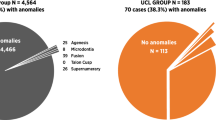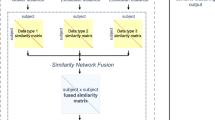Abstract
Background
The purpose of this research study was to evaluate the earliest markers of vocal functioning and neurological development in infants with isolated oral cleft of the lip and/or palate (iCL/P).
Methods
Participants were recruited through advertisements and clinic visits at a local mid-western university. A total of eight participants (four unaffected and four with iCL/P), ranging in age from 7.29 to 11.57 weeks, were enrolled and completed demographic and pre-speech measures. A subset of six males (four unaffected and two with iCL/P) successfully completed a structural magnetic resonance imaging scan.
Results
Patterns of disrupted vocal control and reduced myelinated white matter were found in participants with iCL/P.
Conclusions
The findings of this study provide a foundation from which to build further research on the neuronal development of infants with oral clefts: the need to evaluate measures of cortical development, inclusion of information on anesthesia exposure and airway obstruction, and suggestions for avoiding identified pitfalls/blocks to obtaining data are discussed.
Impact
-
Research in children with isolated oral clefts has demonstrated higher rates of learning disorders connected to subtle differences in brain structure.
-
There is no work evaluating the potential impact of exposure to anesthesia on development.
-
This is the first known attempt to evaluate brain structure and function in infants with isolated oral clefts before exposure to anesthesia.
-
Potential trends of early vocal issues and structural brain differences (less myelinated white matter) were identified in infants with isolated oral clefts compared to unaffected controls.
-
Differences in brain structure and function in infants with isolated oral clefts may be present before surgery.
Similar content being viewed by others
Log in or create a free account to read this content
Gain free access to this article, as well as selected content from this journal and more on nature.com
or
References
Nopoulos, P. et al. Abnormal brain morphology in patients with isolated cleft lip, cleft palate, or both: a preliminary analysis. Cleft Palate Craniofac. J. 37, 441–446 (2000).
Nopoulos, P., Langbehn, D. R., Canady, J., Magnotta, V. & Richman, L. Abnormal brain structure in children with isolated clefts of the lip or palate. Arch. Pediatr. Adolesc. Med. 161, 753–758 (2007).
Yang, F. F., McPherson, B., Shu, H., Xie, N. & Xiang, K. Structural abnormalities of the central auditory pathway in infants with non-syndromic cleft lip and/or palate. Cleft Palate Craniofac. J. 49, 137–145 (2011).
Nopoulos, P. et al. Hyperactivity, impulsivity, and inattention in boys with cleft lip and palate: relationship to ventromedial prefrontal cortex morphology. J. Neurodev. Disord. 2, 235–242 (2010).
Boes, A. D. et al. Social function in boys with cleft lip and palate: relationship to ventral frontal cortex morphology. Behav. Brain Res. 181, 224–231 (2007).
Shriver, A. S., Canady, J., Richman, L., Andreasen, N. C. & Nopoulos, P. Structure and function of the superior temporal plane in adult males with cleft lip and palate: pathologic enlargement with no relationship to childhood hearing deficits. J. Child Psychol. Psychiatry 47, 994–1002 (2006).
Conrad, A. L. et al. Cerebellum structure differences and relationship to speech in boys and girls with nonsyndromic cleft of the lip and/or palate. Cleft Palate Craniofac. J. 47, 469–475 (2010).
Conrad, A. L., Goodwin, J. W., Choi, J., Block, R. I. & Nopoulos, P. The relationship of exposure to anesthesia on outcomes in children with isolated oral clefts. J. Child Neurol. 32, 308–315 (2017).
Cielo, C. M. et al. Evolution of obstructive sleep apnea in infants with cleft palate and micrognathia. J. Clin. Sleep Med. 12, 979–987 (2016).
Muntz, H. R. Management of sleep apnea in the cleft population. Curr. Opin. Otolaryngol. Head. Neck Surg. 20, 518–521 (2012).
Smith, C. B., Walker, K., Badawi, N., Waters, K. A. & MacLean, J. E. Impact of sleep and breathing in infancy on outcomes at three years of age for children with cleft lip and/or palate. Sleep 37, 919–925 (2014).
Burdi, A. R. in Cleft Lip and Palate (ed. Berkowitz, S.) 3–12 (Springer, New York, 2006).
Sperber, G. H. First year of life: prenatal craniofacial development. Cleft Palate Craniofac. J. 29, 109–111 (1992).
Wermke, K. et al. The vocalist in the crib: the flexibility of respiratory behaviour during crying in healthy neonates. J. Voice (2019).
Koopmans-van Beinum, F. & van der Stelt, J. in Precursors of Early Speech (eds Lindblom, B. & Zetterström, R.) 37–50 (Palgrave Macmillan UK, London, 1986).
Wermke, K. in International Encyclopedia of the Social & Behavioral Sciences 2nd edn (ed Wright, J.) 475–480 (Elsevier, Oxford, 2015).
Wermke, K. et al. Cry melody in 2-month-old infants with and without clefts. Cleft Palate Craniofac. J. 48, 321–330 (2011).
Robb, M. P. et al. Laryngeal constriction phenomena in infant vocalizations. J. Speech Lang. Hear. Res. 63, 49–58 (2020).
Wermke, K., Mende, W., Manfredi, C. & Bruscaglioni, P. Developmental aspects of infant’s cry melody and formants. Med. Eng. Phys. 24, 501–514 (2002).
Newman, J. D. Neural circuits underlying crying and cry responding in mammals. Behav. Brain Res. 182, 155–165 (2007).
Boersma, P. & Weenink, D. PRAAT: doing phonetics by computer [Computer Program]. Version 5.4: retrieved November 2014 from http://www.praat.org/.
Kim, R. et al. (eds). Clinical Image-Based Procedures. Translational Research in Medical Imaging. CLIP 2015. Lecture Notes in Computer Science (Springer, Cham, 2016).
Talairach, J. & Tournoux, P. Co-Planar Stereotaxic Atlas of the Human Brain (Thieme Medical Publishers, New York, 1988).
Fedorov, A. et al. 3D slicer as an image computing platform for the quantitative imaging network. Magn. Reson. Imaging 30, 1323–1341 (2012).
Nopoulos, P. et al. Cognitive dysfunction in adult males with non-syndromic clefts of the lip and/or palate. Neuropsychologia 40, 2178–2184 (2002).
Yang, F. F., McPherson, B., Shu, H. & Xiao, Y. Central auditory nervous system dysfunction in infants with non-syndromic cleft lip and/or palate. Int. J. Pediatr. Otorhinolaryngol. 76, 82–89 (2012).
Acknowledgements
We thank the Cleft Palate Foundation and Dr. Deborah Kacmarynski who provided financial support to this project. We would also like to thank Joel Bruss who went above and beyond to process the youngest brain images our lab has obtained. Finally, we would like to extend our sincerest gratitude to the families who allowed their infants to participate in this study.
Author information
Authors and Affiliations
Contributions
A.L.C.: Contributed to design of the work; acquisition, analysis, and interpretation of data; and revision and final approval of the manuscript. K.W.: Contributed to design of the work; acquisition, analysis, and interpretation of data; and revision and final approval of the manuscript. M.E.: Contributed to acquisition and analysis of data, and final approval of the manuscript. E.K.: Contributed to acquisition and analysis of data, and final approval of the manuscript. A.B.: Contributed to analysis and interpretation of data, and revision and final approval of the manuscript. T.K.: Contributed to analysis and interpretation of data, and revision and final approval of the manuscript. V.M.: Contributed to design of the work, and revision and final approval of the manuscript. This study was funded by grants through the Cleft Palate Foundation (PI: A.L.C., Ph.D.) and a University of Iowa Foundation Fund through the Department of Otolaryngology (Director: Deborah Kacmarynski, M.D.).
Corresponding author
Ethics declarations
Competing interests
The authors declare no competing interests.
Patient consent
Parents/guardians of infants provided written consent for their child to participate.
Additional information
Publisher’s note Springer Nature remains neutral with regard to jurisdictional claims in published maps and institutional affiliations.
Rights and permissions
About this article
Cite this article
Conrad, A.L., Wermke, K., Eisenmann, M. et al. Preliminary evaluation of pre-speech and neurodevelopmental measures in 7–11-week-old infants with isolated oral clefts. Pediatr Res 89, 85–90 (2021). https://doi.org/10.1038/s41390-020-0887-5
Received:
Revised:
Accepted:
Published:
Issue date:
DOI: https://doi.org/10.1038/s41390-020-0887-5
This article is cited by
-
Melodic and articulatory development is delayed in deaf infants aged 2–4 months
Scientific Reports (2025)



